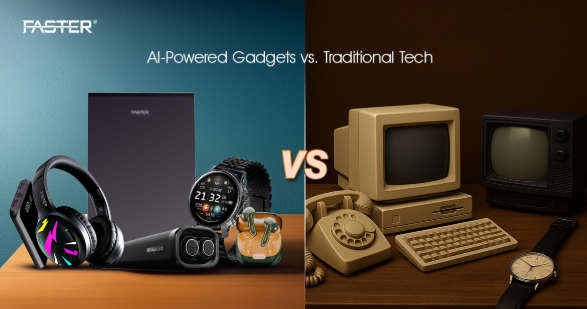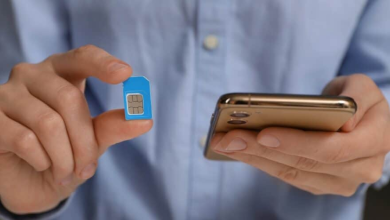AI-Powered Gadgets vs. Traditional Tech: Is the Upgrade Worth It?

From smart assistants that schedule your meetings to wearables that understand your sleep cycles, artificial intelligence is no longer just a buzzword, it’s embedded into the very gadgets we use every day. This rise of AI-powered consumer technology has redefined how devices interact with us, learn from us, and serve us better.
Meanwhile, traditional tech, while dependable, has started to show its age in a world that expects personalization, automation, and real-time insights. So the question arises: is making the switch to AI-powered gadgets truly worth it?
This article breaks down the real-world differences between AI-powered and traditional technology,highlighting the core benefits, smart use cases, and standout gadgets that make the upgrade a compelling shift for modern users.
What Sets AI-Powered Gadgets Apart?
Static vs. Adaptive Technology
Traditional gadgets operate with pre-programmed logic. A standard digital watch tells time. A regular speaker plays audio when connected. There’s no adaptation or real-time decision-making.
AI-powered devices, on the other hand, learn behaviors, adapt settings automatically, and often make independent decisions based on data input and usage patterns. For example:
- A fitness band tracks your baseline activity and adjusts daily goals dynamically.
- Smart earbuds recognize noisy environments and automatically optimize sound clarity.
- Smartwatches can detect stress or irregular heart rhythms and alert you preemptively.
This adaptive nature is the defining strength of AI-powered gadgets, they evolve with you, not just serve you.
The Benefits of Upgrading to AI-Powered Tech
1. Personalized User Experience
AI gadgets study your preferences, patterns, and behaviors to optimize how they function:
- Smart thermostats learn your routines and adjust temperatures automatically.
- AI-based audio devices tailor EQ settings for your ear shape and environment.
- Fitness trackers like Faster Nerv Smartwatches analyze your biometric data and offer customized health insights
This personalization ensures every user interaction is more relevant, efficient, and enjoyable.
2. Hands-Free Convenience
Forget manual settings. AI tech offers gesture recognition, voice command and contextual awareness. With AI:
- Smart assistants can schedule meetings and answer queries with natural voice prompts.
- Smart earbuds like those from the Faster Earbuds collection can pause audio when you start speaking.
- AI cameras recognize known faces and distinguish between people, pets, and shadows.
These devices reduce friction in day-to-day interaction.
3. Continuous Learning and Updates
Unlike traditional devices that remain static, AI gadgets evolve:
- Over-the-air (OTA) software updates allow gadgets to get smarter.
- AI processors can adapt to new situations without user intervention.
- A device bought today could be far more capable a year from now due to smarter algorithms.
It’s not just about smarter devices, it’s about devices that improve with time.
4. Proactive Assistance and Automation
AI technology is inherently proactive:
- A smart health band might suggest hydration if it senses fatigue.
- AI-enabled earbuds could adjust noise cancellation based on your location.
- Wearables like the Faster Nerv Watch can detect abnormal heart rates or sleep disruptions and prompt intervention.
Traditional tech only reacts. AI tech anticipates.
AI vs. Traditional Tech Across Key Categories
As AI becomes embedded in our everyday devices, it’s important to understand how it compares to traditional tech across major categories. Here’s how AI is transforming gadgets you already use — from audio gear to wearables, cameras, and productivity tools.
1. Smart Audio Devices
Traditional earbuds typically offer static audio profiles with basic Bluetooth pairing and playback. Regardless of your environment—on a crowded street or in a quiet room—the sound remains the same, with little adaptability.
AI-powered earbuds, like the Faster Earbuds E20 Pro, are changing that by introducing contextual intelligence into your listening experience:
- Adaptive noise cancellation that adjusts to real-time ambient noise.
- Smart in-ear detection that pauses your music when you remove an earbud.
- AI-enhanced microphones that reduce background sounds during voice calls.
These features create a seamless, intuitive interaction between the listener and their environment, giving you more control, clearer audio, and less manual adjustment.
2. Health and Fitness Wearables
Conventional fitness trackers are good at logging metrics like steps, heart rate, and sleep, but that’s where their functionality ends. They present raw data without helping users interpret or act on it.
AI-powered wearables like those in the Faster Nerv Watches series bridge this gap with personalized, intelligent insights:
- Trend analysis across sleep, stress, heart rate, and blood oxygen.
- Custom health prompts based on your past activity.
- Proactive alerts when anomalies are detected in your vitals.
This isn’t just about tracking, it’s about understanding. AI transforms health tech into something predictive and personalized, making wearables far more valuable.
3. Smart Assistants and Home Control
The gap between traditional home controls and AI-enabled assistants is vast. Wall switches and remote controls operate in isolation, you press a button, and it executes a command. There’s no context or learning involved.
By contrast, AI-based home systems (like Google Nest, Amazon Echo, or AI-ready devices from Faster Pakistan) create a responsive, voice-controlled environment:
- Natural language understanding for seamless voice commands.
- Routine automation, like dimming lights, turning on the AC, and starting a playlist, all in one voice prompt.
- Context awareness, where systems adapt based on your schedule or presence in the room.
The result is a smarter, more connected home where tech works with you instead of waiting for your input.
4. Visual Devices and Smart Cameras
Traditional security cameras capture footage but can’t distinguish what’s important. Every motion triggers an alert—be it a swaying curtain, a moving pet, or falling leaves.
AI-powered cameras solve this with intelligent recognition capabilities:
- Smart motion detection that identifies people vs. animals or vehicles.
- Reduced false alerts thanks to machine learning.
- Pattern recognition, where the system learns what’s “normal” and flags anomalies.
Devices like the TP-Link Tapo C225 or EufyCam series incorporate these AI features to make home surveillance smarter, more accurate, and less disruptive.
5. Personal Productivity
Traditional tech tools like timers, calendars, or headphones help you work, but they don’t anticipate your needs or evolve based on your habits.
AI-powered productivity gadgets, on the other hand, integrate into your routine and help you optimize it:
- Real-time language translation through AI-driven earbuds.
- Health-conscious smartwatches, like those from Faster Nerv Watches, prompt breaks during long work hours.
- Smart displays (like Google Nest Hub or Amazon Echo Show) suggest focus blocks, analyze your to-do list, and adjust your schedule proactively.
AI doesn’t just improve productivity, it reshapes it around your unique working style, enabling smarter decisions and smoother workflows.
Notable AI-Powered Gadgets Worth the Upgrade
Here are a few standout AI-powered gadgets delivering smart, meaningful value.
Faster Earbuds F20 Pro
These true wireless earbuds combine affordability with adaptive intelligence:
- Auto-connect and smart pause
- Noise reduction based on ambient sound
- Long battery life and smart touch controls
Offered by Faster Pakistan, they represent an ideal entry into AI-audio ecosystems, built for clarity, convenience, and ongoing learning. You can explore more earbuds in the full Faster Earbuds collection.
Faster Nerv Watch
More than a fitness tracker, this AI-powered smartwatch does the following:
- Analyzes stress and SpO₂ levels
- Suggests activity and rest windows based on trends
- Supports Bluetooth calling and customizable alerts
Its AI-driven features support smarter health choices daily. Explore more via Faster Nerv.
Sony WH-1000XM5
Sony’s flagship headphones use AI-powered adaptive sound control to:
- Recognize your activity (walking, sitting, commuting)
- Adjust ANC and ambient sound levels accordingly
- Use beamforming mics and noise sensing for clear calls
Fitbit Sense 2
A health-focused wearable that:
- Tracks stress with skin conductance sensors
- Uses AI to evaluate sleep quality and suggest changes
- Offers actionable insights through connected app AI coaching
Google Nest Hub
This smart display is powered by Google Assistant and machine learning:
- Detects motion with radar
- Shows relevant info like weather, calendar, reminders
- Learns user patterns to suggest timely content
It’s the perfect example of ambient computing—where your device quietly works around you.
When Is the AI Upgrade Worth It?
AI-powered gadgets are worth the upgrade when:
- You value personalization over presets
- You seek hands-free, seamless interaction
- You want a device that evolves with software updates
- You prioritize automation and productivity
- You benefit from smarter health insights and notifications
Whether it’s through adaptive audio, intuitive health tracking, or proactive assistance, AI gadgets simplify life without you needing to ask.
Experience Smarter Living
In a world increasingly shaped by intelligent systems, sticking to traditional tech may mean missing out on functionality, freedom, and future-readiness.
The gap between static and smart has grown too wide to ignore. AI-powered gadgets now deliver:
- Real-time adaptability
- Proactive insights
- Personalized experiences
- Long-term performance improvements
For users ready to invest in smarter living, the upgrade to AI-powered gadgets isn’t just worth it, it’s transformative.
And with brands like Faster Pakistan leading innovation with collections like the Faster Earbuds and Faster Nerv, the leap into intelligent technology is more accessible than ever.
Let your devices learn you, not the other way around. That’s the future of tech.



